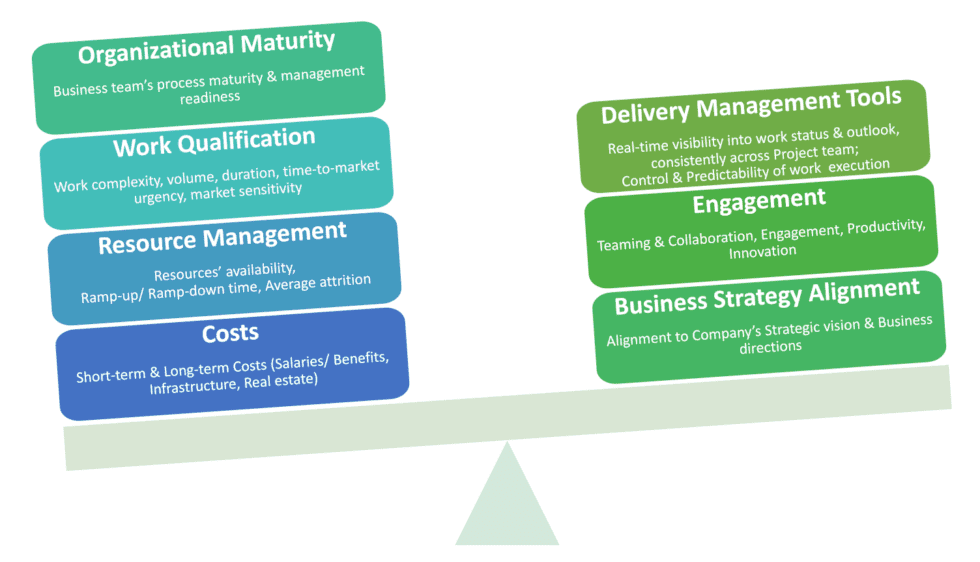Background
Are you a Small/ Medium Business owner or Decision maker, under pressure to scale up cost-effectively? Are you lost whether to hire internally, hire local contractors, outsource to an offshore or nearshore vendor, or freelance your work? Or do you go for a mix of these methods? Here’s some guidance for you.
By the way: Is the following guide also relevant for Enterprises? Yes, but with some enhancements. More on this later.
Pros & Cons of different Service delivery methods
Traditional Freelancing is inherently risky. When we execute work via typical online freelancing platforms, we end up being disconnected from work execution. Obviously, we can plan for Milestone-based deliveries, and keep in touch by viewing dashboards & regularly reviewing status reports, etc, but that does not replace the control that you have with your own, in-site teams.
Also, identifying the right freelancers for your job is always a challenge, due to the need to wade through details about freelancers’ skills, portfolios, and experience match with your Jobs as well as your cost constraints, in order to identify the best freelancers for your Jobs.
On the other hand, hiring your in-house teams come with a very large burden — real estate, salaries & benefits, infrastructure, etc. Also, hiring your own team takes time: Time to shortlist, interview, and finalize the right candidates, make an offer, get their acceptance, serve notice periods, join your team, and get deployed. Further, if your work pipeline is interrupted, then you end up carrying the burden of unoccupied resources & burning up valuable cash.
You have the option to engage local contractors to execute your work, and avoid the long-term burden of salaries & benefits. However, the burden of costs relating to real estate & infrastructure still remain. Further, short-term costs would increase when you use local contractors.
Outsourcing is definitely another option. But the Cost benefits from Outsourcing is diminishing due to increasing costs relating to real estate, salaries & benefits, infrastructure, etc. As a result, we are seeing a lot of outsourcing migrating away from India to Eastern Europe, South-east Asia, etc. However, these regions do not have the proliferation of English-speaking resources that India has, which is a challenge to scaling up. Also, setup of new Outsourcing contracts is very expensive due to the need to support parallel teams during the setup period, initial investments in real estate & infrastructure, etc.
So Outsourcing makes sense when the contract period is relatively long, so as to permit recouping of initial expenses, but does not make sense for scenarios where work pipeline go through a peaking-and-waning pattern.
So what are the are the aspects to be considered while taking the decision on your Sourcing strategy & Service delivery methods ?
Key considerations for the Service delivery method decision

The factors to be considered to get to a decision whether to hire staff, engage local contractors, outsource to a third party, or freelance, may include:
Qualification of Work
1. Quantum of work pipeline available & its complexity
2. Is the work going to continue for the long-term, or is it only visible for a fixed term
3. Is the work output tangible or intangible, and the need for physical proximity to execute work effectively
4. Privacy & Confidentiality aspects of work scope & data
5. Market sensitivity, Security, & Compliance aspects of work to be performed
6. Urgency of work to be performed, for any immediate-term work
Resource Management
7. Lead time for hiring new staff vs engaging local contractors vs setting up a productive outsourcing team
8. Availability of resources with adequate bandwidth within your own organization, to perform your work
9. Average attrition rate of staff in the business organization’s region
10. Availability of resources for hire or as local contractors in the region
11. Availability of resources for hire in the Outsourcing vendors’ region
12. Average attrition rate of staff in the Outsourcing vendor’s region
Costs
13. Short-term & long-term costs relating to hiring new employees
14. Short-term & long-term costs relating to engaging local contractors
15. Short-term & long-term costs relating to infrastructure & real-estate setup
16. Short-term & long-term costs for setting up an Outsourcing engagement
Business enablers & constraints
17. Productivity, Organizational learning, Innovation needs of the Business
18. Short-term & Long-term Budgetary constraints on the Business
19. Organizational process maturity of the Business — Service Delivery process maturity; Resource Management process maturity; Performance Management Process maturity; Vendor Management process maturity; Logistics & Supply Management process maturity; Financial Management process maturity; etc, as well as the Tools framework supporting the various processes
20. Line Management preparedness of the Business team, to manage the scale-up & any additional technical/administrative/financial/general management needs.
Businesses can also critically examine their work pipeline & see how they can split up the work content into different streams, and assign each stream to a Service delivery method.
Bottomline: Its clear that Businesses need to approach the decision of service delivery method selection in a very structured manner.
Can you identify any factors that have been missed out above? Do you see any other aspect of the Sourcing strategy & Service Delivery method decision that has not been considered?
Please submit your inputs as comments in this post.
The next post in this series is coming soon: Do you want to safely increase adoption of Freelancing in your Business? Assess your readiness first (Link).
By the way, you may also like to read other articles in this series. The immediately previous one was titled: How Outsourcing is evolving, and how Businesses and Service Providers can leverage this evolution (Link).
You may also find this related article interesting: How to drive more value from Freelancing: An Evolution of Freelancing models (Link).



